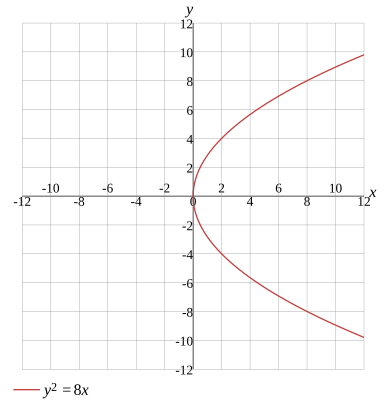Question
Identify the conic
Find the standard equation of the parabola
Find the vertex of the parabola
Find the focus of the parabola
Load more

y2=8x
Evaluate
y2−8x=0
Move the expression to the right-hand side and change its sign
y2=0−(−8x)
If a negative sign or a subtraction symbol appears outside parentheses, remove the parentheses and change the sign of every term within the parentheses
y2=0+8x
Solution
y2=8x
Show Solution

Solve the equation
Solve for x
Solve for y
x=8y2
Evaluate
y2−8x=0
Move the expression to the right-hand side and change its sign
−8x=0−y2
Removing 0 doesn't change the value,so remove it from the expression
−8x=−y2
Change the signs on both sides of the equation
8x=y2
Divide both sides
88x=8y2
Solution
x=8y2
Show Solution

Testing for symmetry
Testing for symmetry about the origin
Testing for symmetry about the x-axis
Testing for symmetry about the y-axis
Not symmetry with respect to the origin
Evaluate
y2−8x=0
To test if the graph of y2−8x=0 is symmetry with respect to the origin,substitute -x for x and -y for y
(−y)2−8(−x)=0
Evaluate
More Steps


Evaluate
(−y)2−8(−x)
Multiply the numbers
(−y)2−(−8x)
Rewrite the expression
(−y)2+8x
Rewrite the expression
y2+8x
y2+8x=0
Solution
Not symmetry with respect to the origin
Show Solution

Find the first derivative
Find the derivative with respect to x
Find the derivative with respect to y
dxdy=y4
Calculate
y2−8x=0
Take the derivative of both sides
dxd(y2−8x)=dxd(0)
Calculate the derivative
More Steps


Evaluate
dxd(y2−8x)
Use differentiation rules
dxd(y2)+dxd(−8x)
Evaluate the derivative
More Steps


Evaluate
dxd(y2)
Use differentiation rules
dyd(y2)×dxdy
Use dxdxn=nxn−1 to find derivative
2ydxdy
2ydxdy+dxd(−8x)
Evaluate the derivative
More Steps


Evaluate
dxd(−8x)
Use differentiation rule dxd(cf(x))=c×dxd(f(x))
−8×dxd(x)
Use dxdxn=nxn−1 to find derivative
−8×1
Any expression multiplied by 1 remains the same
−8
2ydxdy−8
2ydxdy−8=dxd(0)
Calculate the derivative
2ydxdy−8=0
Move the constant to the right-hand side and change its sign
2ydxdy=0+8
Removing 0 doesn't change the value,so remove it from the expression
2ydxdy=8
Divide both sides
2y2ydxdy=2y8
Divide the numbers
dxdy=2y8
Solution
dxdy=y4
Show Solution

Find the second derivative
Find the second derivative with respect to x
Find the second derivative with respect to y
dx2d2y=−y316
Calculate
y2−8x=0
Take the derivative of both sides
dxd(y2−8x)=dxd(0)
Calculate the derivative
More Steps


Evaluate
dxd(y2−8x)
Use differentiation rules
dxd(y2)+dxd(−8x)
Evaluate the derivative
More Steps


Evaluate
dxd(y2)
Use differentiation rules
dyd(y2)×dxdy
Use dxdxn=nxn−1 to find derivative
2ydxdy
2ydxdy+dxd(−8x)
Evaluate the derivative
More Steps


Evaluate
dxd(−8x)
Use differentiation rule dxd(cf(x))=c×dxd(f(x))
−8×dxd(x)
Use dxdxn=nxn−1 to find derivative
−8×1
Any expression multiplied by 1 remains the same
−8
2ydxdy−8
2ydxdy−8=dxd(0)
Calculate the derivative
2ydxdy−8=0
Move the constant to the right-hand side and change its sign
2ydxdy=0+8
Removing 0 doesn't change the value,so remove it from the expression
2ydxdy=8
Divide both sides
2y2ydxdy=2y8
Divide the numbers
dxdy=2y8
Cancel out the common factor 2
dxdy=y4
Take the derivative of both sides
dxd(dxdy)=dxd(y4)
Calculate the derivative
dx2d2y=dxd(y4)
Use differentiation rules
dx2d2y=4×dxd(y1)
Rewrite the expression in exponential form
dx2d2y=4×dxd(y−1)
Calculate the derivative
More Steps


Evaluate
dxd(y−1)
Use differentiation rules
dyd(y−1)×dxdy
Use dxdxn=nxn−1 to find derivative
−y−2dxdy
dx2d2y=4(−y−2dxdy)
Rewrite the expression
dx2d2y=4(−y2dxdy)
Calculate
dx2d2y=−y24dxdy
Use equation dxdy=y4 to substitute
dx2d2y=−y24×y4
Solution
More Steps


Calculate
−y24×y4
Multiply the terms
More Steps


Multiply the terms
4×y4
Multiply the terms
y4×4
Multiply the terms
y16
−y2y16
Divide the terms
More Steps


Evaluate
y2y16
Multiply by the reciprocal
y16×y21
Multiply the terms
y×y216
Multiply the terms
y316
−y316
dx2d2y=−y316
Show Solution

Rewrite the equation
r=0r=8cos(θ)csc2(θ)
Evaluate
y2−8x=0
To convert the equation to polar coordinates,substitute x for rcos(θ) and y for rsin(θ)
(sin(θ)×r)2−8cos(θ)×r=0
Factor the expression
sin2(θ)×r2−8cos(θ)×r=0
Factor the expression
r(sin2(θ)×r−8cos(θ))=0
When the product of factors equals 0,at least one factor is 0
r=0sin2(θ)×r−8cos(θ)=0
Solution
More Steps


Factor the expression
sin2(θ)×r−8cos(θ)=0
Subtract the terms
sin2(θ)×r−8cos(θ)−(−8cos(θ))=0−(−8cos(θ))
Evaluate
sin2(θ)×r=8cos(θ)
Divide the terms
r=sin2(θ)8cos(θ)
Simplify the expression
r=8cos(θ)csc2(θ)
r=0r=8cos(θ)csc2(θ)
Show Solution

Graph
